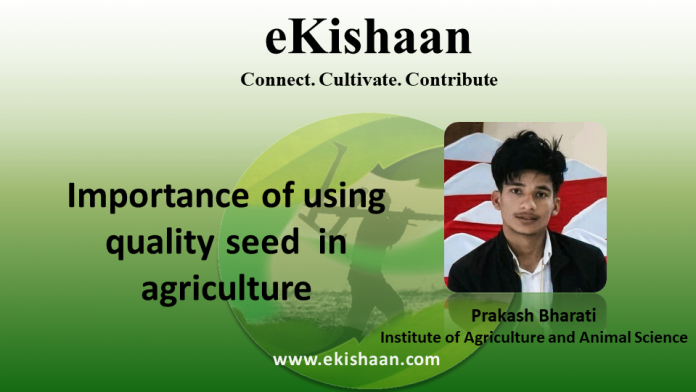Importance of using quality seed in agriculture
Seeds are the food for people, livestock, and birds. They are the abundance, they are the elegance, they are the emblem of the start. In broad sense seed is a medium used to grow or regenerate seed. Seed is a mature fertilized ovule filled with seed coat called seed or it is a propagating substance.
It also refers to the propagation of materials from good seedlings, tuber, bulbs, rhizome, roots, cuttings, locations, all types of grafts and the propagation of vegetative materials used for growth.
Importance of seed
- Seeds are the first determinant of future plant development. The seed is the key to success in cultivation.
- Seeds are crucial and essential inputs to increase crop yields per unit area. There is a clear reference in ancient literature to Yajurveda, “May the seed be viable, may the rains be plentiful and may the grains ripen for days and nights”
- Green revolution was only possible with the production of generally high quality seeds with other qualities, namely high germination, high vigour, high physical purity and sound health. So the green revolution is actually the seed revolution.
- Only seeds of assured quality can be expected to respond to fertilizers and other inputs in the expected manner, otherwise the seed of hope may turn into a seed of frustration.
- Among the inputs used by farmers for the cheapest input of seed. These are basic inputs and form a small part of the total cost of cultivation.
- Quality seed eventually increases the performance of the crop production factor
Quality of seed and its importance
Quality seed is described as varietal purity with a high percentage of germination, free from disease and pest, and with a proper moisture content and weight. Quality seed ensures strong germination, rapid growth and robust development.
This dimension is converted into a good field plant stand. Poor quality seed results in unnecessary thinning or yield reduction due to overcrowding, all of which minimize profitability.
Quality seed is a vital input into crop production: it is the cheapest input into crop production and the key to progress in agriculture. Crop output depends to a large extent on the seed material used for sowing and the response of other inputs to crop production depends on the seed material used.
The seed required for growing crops is quite high, and the cost is much lower compared to other inputs. It is estimated that good quality seeds for improved varieties will lead to an increase of about 20-25% in yield. Quality seeds are critical in improving the potential yield output of the species and the variety.
The use of high quality seeds is one of the most important elements in increasing agricultural production in any farming system. This element has become more crucial than ever for providing enough food security for the rising number of people in the world, which is expected to exceed nine billions by year 2050. Selecting high yielding varieties adapted to the area of production, with disease, insect, lodging, and shattering resistance, along with other desirable characteristics are basic keys for satisfactory crop performance and yield. The production of high quality seed is the cornerstone of any successful agriculture program. It is also a good marketing tool for increasing the potential sale of crops, especially in today’s competitive market. Many people wonder what does seed quality mean? The practical definition of seed quality can differ depending on the end user. For example, a farmer may desire high-quality seed that produces rapid uniform plants with high yielding capacity under a wide range of field conditions. A producer of oil seed crop, where oil would be used for industrial purposes such as making soap, cosmetic products or lubricants may desire seed with a particular stable fatty acid profile as a measure of high quality.
Success in producing quality seed of a particular crop in one area and failure in another area illustrates the importance of environmental influence on seed development and maturation. Environmental conditions during seed development and maturation, including temperature, water stress or excessive rain, lack of nutrients, disease infestation, and insect pressure influence seed quality. The stage of seed development at harvest also affects seed quality. Harvesting too early or too late may reduce the quality of the seeds. During prolonged and less than optimum storage conditions, physiological, biochemical, and cytological changes occur in seeds, leading to the deterioration of their quality. Slower growth rate, abnormal seedlings, and loss of vigor and viability are among the physiological changes. Mechanical injuries due to harvesting, conditioning, and handling can also affect seed quality. Storing seed under poor conditions of high temperature and relative humidity or at high moisture content accelerates seed deterioration and reduces its quality. The extent of seed deterioration depends on species, storage environment, length of storage period, and the initial quality of the stored seeds. Therefore, testing the quality of seeds stored for different lengths of time is important to determine the effect of aging on seed quality.
In summary, the production of high quality seeds does not happen by chance. Each step in the production system from planting the proper variety in appropriate time to following weed control practice, fertility program, harvest in the right time, cleaning the seeds, storage, and shipping is critical for achieving high quality seeds.
